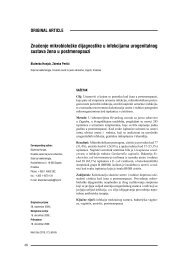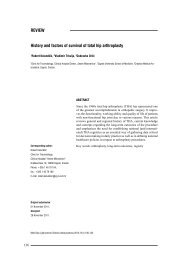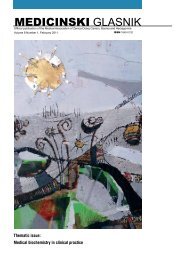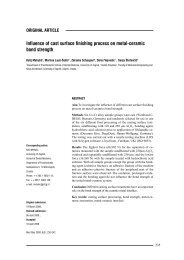MEDICINSKI GLASNIK
MEDICINSKI GLASNIK
MEDICINSKI GLASNIK
Create successful ePaper yourself
Turn your PDF publications into a flip-book with our unique Google optimized e-Paper software.
26<br />
Medicinski Glasnik, Volumen 9, Number 1, February 2012<br />
(from different patients) and forwards them to the<br />
communication network area.<br />
Communication network area interconnects the<br />
local sensory area with the institutional network<br />
in a medical institution (e.g. hospital). Different<br />
types of networks can be used for this purpose,<br />
e.g. the Internet, cellular network (2G/3G), Wi-<br />
MAX. All obtained data are analysed, aggregated<br />
and stored into the database on the healthcare<br />
server. Every patient has his/her own record, properly<br />
secured and with restricted access. Medical<br />
personnel (e.g. physicians, nurses) have access to<br />
the patient records through the local secured institutional<br />
network. They may have different levels<br />
of access rights, according to the current institutional<br />
policies. The described architecture of the<br />
telemedicine system is illustrated in Figure 3.<br />
A very important issue in telemedicine systems is<br />
to provide the security and privacy of patient-related<br />
data. Providing data security usually implies<br />
that the data is securely stored and transferred<br />
through the network. The data privacy connotes<br />
that the data can only be accessed by authorized<br />
personnel. Securely stored data means that their<br />
confidentiality and integrity are assured. The<br />
stored data should also be retrievable in case of<br />
failure of sensor node or handheld device.<br />
Data access security implies the implementation<br />
of fine-grained data access policy that prevents<br />
the unauthorized access to sensitive patient-related<br />
data. The authentication of data sender should<br />
also be ensured in order to prevent the injection<br />
of false data from the outside. Constant availability<br />
of patient data is also an imperative.<br />
Data security and privacy are usually ensured by<br />
implementation of different encryption schemes,<br />
usually based on predistributed shared keys. The<br />
Figure 3. General architecture of the telemedicine system (Grgić K., 2011)<br />
implementation of security mechanisms represents<br />
a big challenge due to strong resource constraints<br />
of sensor nodes. Therefore, the security<br />
mechanisms need to be as lightweight as possible<br />
for a specific application.<br />
It is also important to standardize the interfaces<br />
between different components of the telemedicine<br />
system. Such approach enables an easier<br />
expansion of the system, as well as an easier<br />
interconnection, integration and data exchange<br />
between different systems. At the same time, the<br />
interface for the patients has to be user friendly<br />
and easy to use.<br />
BASN EXAMPLES WORLDWIDE<br />
Body area sensor networks represent the fundamental<br />
basis for the mobile healthcare systems<br />
(often denoted as the mHealth systems). Such systems<br />
are currently the subject of intensive research<br />
efforts worldwide (35, 36, 37). These efforts<br />
have resulted in certain mHealth systems which<br />
are already in practical use, but are also under<br />
further development (38, 39, 40). There are also<br />
several mHealth systems that are in a development<br />
phase under some active research project<br />
(41). The individual body area sensor networks<br />
are usually interconnected with other modern<br />
communication networks (the Internet, cellular<br />
networks) forming a complex global system (42).<br />
The interconnection of BASN networks with the<br />
Internet or cellular network enables remote patient<br />
monitoring through the telemedicine system<br />
(43, 44). This article gives a short survey of some<br />
existing mHealth and telemedicine systems, which<br />
may be useful for the medical practitioners<br />
and researchers, but also for the engineers interested<br />
in the area of sensor networking. Mobile












